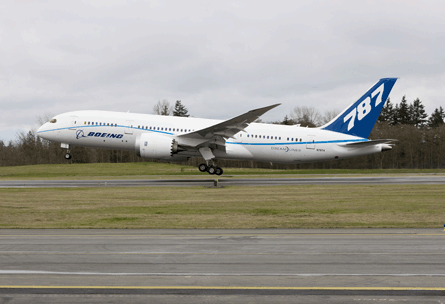Boeing is targeting June to finalise the configuration of the 787-9, as a third Dreamliner joins to the flight-test programme to support the design effort for the larger derivative.
The third 787 to fly is actually the fourth aircraft built (ZA004), but Boeing says the twinjet "is needed more quickly" to collect data used for certification as well as for developing the 787-9. ZA004 made its 3h 4min maiden sortie on 24 February, reaching an altitude of 30,000ft (9,150m) and a speed of 255kt (470km/h).
The fully instrumented aircraft will be used for a flight-loads survey to compare windtunnel and computer modelling against actual loads seen in flight.
 |
|---|
© Boeing |
Boeing is advancing with testing on the 787-8 static airframe, and Pat Shanahan, vice-president of airplane programmes, says that all the internal authorisations to proceed with the ultimate load testing of the wing have been completed. Early tests that will eventually build toward ultimate loading of the wing, he adds, began on 8 February.
Along with the data gathered on the 150-plus hours accumulated during the first two months of 787 flight testing, Boeing has been able to hone its configuration for the 787-9. The 62.8m (206ft)-long 787-9 is 6.1m longer than its smaller stablemate, the 787-8, while maintaining the same 60.1m wingspan, and carries 379 litres (100USgal) less fuel. Deliveries of the 787-9 are due to begin to launch customer Air New Zealand at the end of 2013.
Despite being a heavier aircraft, with a similar-sized wing and slightly less fuel capacity, Boeing is aiming for greater payload and range for the 787-9. The aircraft will have a maximum take-off weight of 247,200kg (545,000lb) and a range of 14,800-15,750km (8,000-8,500nm) with 280 passengers in a three-class configuration.
"Through understanding the performance of the -8 and optimising the configuration" the company has "found a way to get the range and the extra payload", says Shanahan.
Source: Flight International
















